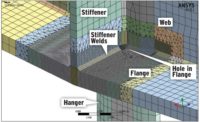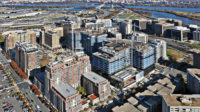Mix-Design Veteran Calls 432 Park Avenue's White Concrete Recipe His Most Challenging Ever
Andreas Tselebidis, who has developed concrete mixes for more than 15 supertowers, says his assignment to design the mix for the world's first extra-high-strength architectural concrete supertower—the 1,397-ft 432 Park Avenue in Manhattan—is his most challenging ever.
With white concrete, finding the right mix for flowability, strength, appearance, production, delivery and casting is like creating "a recipe for a very fussy cake," says Tselebidis, director of sustainable concrete technology and solutions for chemical supplier BASF Corp.
The 432 Park project was especially difficult because white concrete is typically precast, not site-cast, where there is only one chance to get it right, says Tselebidis.
Like any good chef, Tselebidis won't reveal the exact recipe for 432 Park's architectural white concrete, but he will say that "it's a complete engineered solution," based on design and performance specifications, locally available materials, altitude, climate and more.
White cement differs in color from gray cement because of raw materials that contain relatively small amounts of iron oxide and magnesium oxide—compounds that give gray cement its color. White cement also is ground finer relative to typical cements, leading to a faster rate of reaction that can adversely affect concrete slump, workability and set time, says Tselebidis, who has worked on mix designs for more than 40 tall buildings around the world.
Silica fume, which is gray, is typically used in extra-high-strength concrete mixtures. However, because of the white color requirement, the mix instead contains BASF's high-reactivity metakaolin—a dehydroxylated form of the clay mineral kaolinite.
Ferrara Bros. Building Materials Corp. produced a relatively sustainable mix. Only 29% is a white portland cement, which resulted in significant savings with respect to CO² emissions, says Tselebidis.
The basic requirement from a construction perspective was a self-consolidating concrete mix with a target slump-flow spread of 30 in. The required compressive strength varied from 14,000 psi for the lower floors to 10,000 psi for the upper floors. Slight modifications in the mix proportions were made to keep the mix economical and provide the fluidity to pump to the upper floors, adds Tselebidis.
It took 12 mock-ups to get the correct mix to cast the first-floor columns. "Mix design was a major process at the front end," says Peter Rodrigues, executive project manager for superstructure concrete contractor Roger & Sons Concrete Inc.







